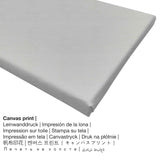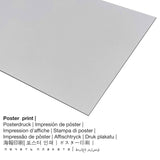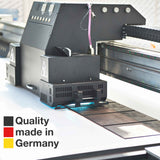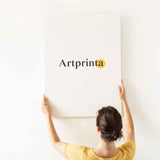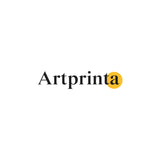Georges-Antoine Rochegrosse, 1903 - the Burgraves - fine art print
inkl. MwSt. zzgl. Versandkosten
Original information about the artwork from Maison de Victor Hugo - Hauteville House (© - by Maison de Victor Hugo - Hauteville House - Maison de Victor Hugo - Hauteville House)
The painting depicts the play of Victor Hugo's "Les Burgraves" scene VI of part two, "The Beggar". The Emperor Frederick Barbarossa in his costume beggar became recognize and claim his title. Magnus then wants to take him: Didascalia "While Magnus told the circle of burgraves slowly tightened around the emperor. Behind burgraves came silently put a triple line of armed soldiers, above which rises the great banner of e burg, mid-part black and red, embroidered with a silver ax in the field in mouths, and the caption under the ax: MONTI COMAM, VIRO CAPUT. The emperor, without a step back, holding the crowd in awe. Suddenly, when Magnus ended, one of burgraves draws his sword. Cadwalla drawing his épée.César! Caesar! Caesar! Make us our citadels! Darius, drawing his épée.Nos burgs, which are only swallows' nests! Hatto, pulling his épée.Rends us our dead friends, who haunt our dungeons, when the wind bitter nights crying through the reeds! Magnus, grabbing his hache.Ah! you go out of the tomb! well, I reject you there, That at that moment - you know, Barbarossa -Where the world will hear a hundred voices with transportCrier: he is alive! echo say, he died - Aspen so foolish that was threatening our heads! "The moment represented, taking the dramatic moment, is the articulation of the stage and more specifically illustrates the beginning of the next stage direction, introducing the replica of Job Didascalia" The burgraves, sword high, press Barbarossa with great cries. Job out of the crowd and raises his hand. All are silent. "Job, the empereur.Sir, my son Magnus told you true. You êtesMon enemy. It is I who, angered soldier, Jadis carried her hand on your majesté.Je hate you. - But I want a Germany monde.Mon folds and bends a country-profonde.Sauvez the shade! I fall to my knees in my lieuDevant emperor that brings my God! "The decor is broadly in line with the instructions of Victor Hugo data at the beginning of the act:" The room of outfits. To the left a door. Basically a gallery niche revealing the sky. Walls of bare basalt. Set rough and severe. suits of armor all pillars. "The emperor is here left back three quarters, dressed as a beggar. Job is on the steps, arms raised. Magnus in dimension gray mesh, rushes, holding the ax. The other three burgraves foreground are probably Cadwalla, Darius and Hatto. Bouquet ground right evokes the previous scene and fainting Regina during the arrest of Otbert by Hatto.
This painting is part of orders placed by Paul Meurice to living artists to the museum opened in 1903. Its first choice is to artists who have already shown the work of Victor Hugo. This is the case of Rochegrosse who gave two complete illustrations of novels, "Han Island" and "The Man Who Laughs" and also gave the designs for "The Burgraves" in volume "theater", published in 1887, the National Edition (Emile Testard and Co., publishers) Paul Meurice supervised, with specific mission to ensure the illustration. So the logic of the order is the same as for Luc-Olivier Merson (see "A Tear for a drop of water"). Presumably this choice is largely Meurice who preferred this because he already had plans for the museum - oils and gouaches - to "Han Island" and "The Man Who Laughs". Above all, Paul Meurice was to hold particularly "Burgraves. He who led the times of Victor Hugo theater at the end of the Second Empire, after the long years of censorship, scheduled for centenary celebrations, the staging of "Burgraves" at the Comédie-French in February 1902. Meurice therefore made much of this piece which nevertheless fail scored the judgment of the theatrical production Victor Hugo, before the exile. He knew how much the trips on the Rhine marks a moment of crystallization of the imagination of Hugo, both on the literary and artistic, with the publication of "Rhine" in 1840 and 1842. "The Burgraves" in 1843 and the flight of his graphic production. Imaginary Hugo will continue to maintain. The five letters of Paul Meurice Rochegrosse that store records of the museum - only two of which are precisely dated - shed light on the genesis of the table. Presumably the order and its subject were arrested with Rochegrosse early after the announcement in June 1901 of the creation of the museum and, in any case, before the performance of the play at the Comédie-French, as can to conclude a letter to the painter Meurice: "I had seen announced the resumption of Burgraves and I was indeed very keen to attend; Thank you for thinking of me. Since you want to let me the choice of seats [...] I would prefer a small box, or if possible a bathtub where I can clearly see the scene. "The September 10, 1902 the painter wrote" I worked on a sketch table Burgraves and after many tests I think I found a composition that will interest you. " Offering the show Meurice Rochegrosse went at it the following month, since in October 31, he thanked the writer: "How much I thank you for the wonderful evening I spent yesterday with you. Besides the great joy that we experienced, I could take some information that will help me hopefully very profitable from the standpoint of the table, which I work this time, hard. "The other two letters, undated, seeking Meurice to come and see the painting; one indicating completion. Unlike Luc-Olivier Merson, Rochegrosse took the opposite view of the work for the National Edition. Freed from the verticality, forced by the page for large engravings inset, he opted for a horizontal and dynamic composition as those of the edition were static. This dynamic research is made sensitive by the choice of subject, the moment of attack that immediately precedes that of allegiance - where burgraves kneel before Barbarossa - the artist had chosen to illustrate the book. Does the sight of the play performed which gave him the desire to move? Or trade with Meurice from which we have seen that he also completed his knowledge of the subject, it again is always showing attentive and present, ensuring observance of the text and the spirit of Hugo and asking or suggesting changes in the table cours.Si Rochegrosse was able to draw on the scenography of 1902, he did not show slave. The stage where he places his action is more kinsman of the Comédie-French that he had designed in 1887, especially in the ornamentation (the general provision is in both cases relatively faithful to the text). As far as we can rely on an illustration published in the press, depicting the same scene, Rochegrosse has, apparently placed his characters in the opposite direction, Barbarossa left and not right. The costumes if they are as close in spirit are differences. They are mainly used here colorist talent Rochegrosse - heightened by its orientalism - to give, in contrast to the austere architecture, the spectacle of a middle-age shimmering, vibrant, reinforcing the dynamism of the composition. If the illustration marks the genesis of orders of Paul Meurice, it establishes dialogue with the artists creates a truly creative reworking.
Les Burgraves (V.HUGO)
Background data about the unique work of art
| Artpiece title: | "the Burgraves" |
| Categorization of the artpiece: | painting |
| Category: | modern art |
| Temporal classification: | 20th century |
| Artwork year: | 1903 |
| Approximate age of artwork: | around 110 years old |
| Original medium: | Oil, Canvas (material) |
| Artwork original dimensions: | Height: 105,5 cm, Width: 135 cm |
| Signature: | Signature - In bottom right "G. Rochegrosse" |
| Exhibited in: | Maison de Victor Hugo - Hauteville House |
| Location of the museum: | Paris, France |
| Museum website: | www.maisonsvictorhugo.paris.fr |
| License of artwork: | public domain |
| Courtesy of: | Maison de Victor Hugo - Hauteville House |
The painter
| Name of the artist: | Georges-Antoine Rochegrosse |
| Jobs of the artist: | painter |
| Artist category: | modern artist |
| Died at the age of: | 79 years |
| Born in the year: | 1859 |
| Place of birth: | Versailles |
| Died: | 1938 |
| Deceased in (place): | El Biar |
Structured product details
| Product classification: | art reproduction |
| Method of reproduction: | reproduction in digital format |
| Production method: | digital printing |
| Provenance: | manufactured in Germany |
| Type of stock: | on demand |
| Intended product usage: | gallery wall, wall art |
| Alignment of the image: | landscape alignment |
| Aspect ratio: | 1.2 : 1 - (length : width) |
| Meaning of the image ratio: | the length is 20% longer than the width |
| Available choices: | canvas print, acrylic glass print (with real glass coating), poster print (canvas paper), metal print (aluminium dibond) |
| Canvas print (canvas on stretcher frame): | 60x50cm - 24x20", 120x100cm - 47x39", 180x150cm - 71x59" |
| Acrylic glass print (with real glass coating) sizes: | 60x50cm - 24x20", 120x100cm - 47x39", 180x150cm - 71x59" |
| Poster print (canvas paper): | 60x50cm - 24x20", 120x100cm - 47x39" |
| Aluminium dibond print: | 60x50cm - 24x20", 120x100cm - 47x39" |
| Framing of the art copy: | not available |
Choose your product material
We offer a range of various materials and sizes for every product. The following sizes and materials are the options we offer you for individualization:
- Aluminium dibond print: These are metal prints on alu dibond with an impressive depth effect - for a modern look and non-reflective surface. For the Print On Aluminum Dibond, we print the favorite work of art onto the surface of the white-primed aluminum composite.
- Printed poster (canvas material): A poster print is a UV printed cotton canvas paper with a slightly rough texture on the surface. The poster print is ideally appropriate for placing your art print in a custom-made frame. Please keep in mind, that depending on the size of the canvas poster print we add a white margin of around 2-6cm round about the print motif, which facilitates the framing with your custom frame.
- Acrylic glass print: An acrylic glass print, which is sometimes referenced as a fine art print on plexiglass, will transform your favorite original artwork into amazing décor and makes a viable alternative to canvas or aluminium dibond art prints. The work of art is printed with state-of-the-art UV printing machines. It makes vivid, sharp color tones. The major benefit of an acrylic glass fine art print is that contrasts plus small color details become identifiable thanks to the fine gradation in the print. The acrylic glass protects your chosen art print against light and external influences for many decades.
- Canvas: A canvas direct print is a printed cotton canvas mounted on a wood stretcher. What is more, canvas print creates a charming and pleasant look. A canvas print has the advantage of being relatively low in weight, which means that it is quite simple to hang the Canvas print without the help of any wall-mounts. Canvas prints are suitable for all kinds of walls.
Things you should know about the artpiece by with the name Georges-Antoine Rochegrosse
This piece of art the Burgraves was painted by the artist Georges-Antoine Rochegrosse in 1903. The over 110 year-old original measures the size: Height: 105,5 cm, Width: 135 cm. Oil, Canvas (material) was applied by the artist as the technique for the artwork. The original painting has the following text as inscrption: "Signature - In bottom right "G. Rochegrosse"". Nowadays, this piece of art is included in the Maison de Victor Hugo - Hauteville House's digital collection located in Paris, France. The modern art artpiece, which belongs to the public domain is being provided with courtesy of Maison de Victor Hugo - Hauteville House.: . Besides this, the alignment of the digital reproduction is in landscape format with an aspect ratio of 1.2 : 1, which implies that the length is 20% longer than the width.
Important information: We try all that we can to describe our products as accurately as possible and to display them visually on the respective product detail pages. At the same time, the tone of the print products, as well as the printing can differ marginally from the image on your screen. Depending on your settings of your screen and the condition of the surface, color pigments may not be printed 100% realistically. Given that our art reproductions are processed and printed by hand, there might also be slight discrepancies in the motif's size and exact position.
Copyright © | Artprinta (www.artprinta.com)


